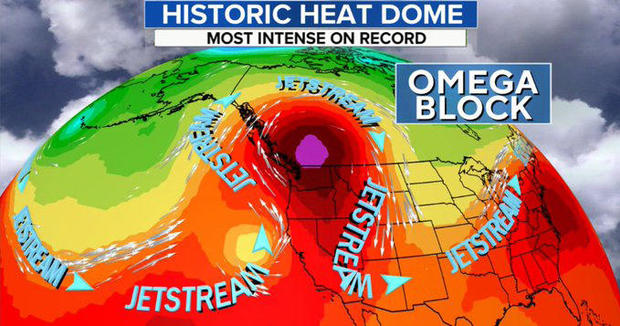For years, the hottest temperatures every recorded anywhere in Canada had never passed 45°C (113°F). Then June 2021 arrived.
All across British Columbia and the prairies, the temperature started skyrocketing. And it refused to stop. In particular, a few areas saw the temperature there nudge past that 45°C mark. And then keep going. This recent heat wave broke temperature records across much of Western Canada—one town hit a national record of 49.6°C (121.2°F) on Tuesday, June 29. Devastating wildfires also hit some areas.
Weather experts—as well as Canadian Prime Minister Justin Trudeau and US President Joe Biden—are saying that heat waves like this one are tied to climate change. But this exact episode had a specific cause.
A heat dome.
How does this occur?

In this graphic, you can see how an air current called the jet stream is trapping high heat in one area. (CBS News/Weather)
In a way, a heat dome is a tiny bit like a reverse polar vortex—that's the phenomenon that takes cold Arctic air and locks it further south than usual, resulting in extreme cold temperatures.
A heat dome is the same idea but with humid, hot air that has arrived from over the ocean.
Normally, air currents carry weather across Canada in a generally west to east pattern. You can see this effect by watching weather radar over a period of time. Whether it is a thunderstorm, a cool period, or a hot blast, the weather tends to move through an area. But sometimes, these air currents travel in a way that locks weather in place.
In a heat dome, air currents trap a huge section of hot humid air and lower it to the ground. The effect is like holding a heat lamp over part of the country. This is what makes a heat dome so dangerous. A day or two of extreme heat is usually part of summer. But many days in a row can be devastating.
Deadly combination
Climate change is not causing heat domes. In fact, a big part of what drives them is a very complex weather event that happens every few years starting over the Pacific Ocean called La Niña. La Niña affects weather patterns around the world. It brings unusual storms to some places and drought to others.
But what climate change is causing is higher that normal temperatures. So when a heat dome happens, it is a hotter heat dome than usual. This is what makes heat waves like this a big issue—and why climate activists are so determined to have world leaders address the problem. Though this heat dome has finally been unlocked, scientists worry that future ones could be even hotter.
 The hot weather in British Columbia eventually led to wildfires in places. (ID 129605383 © Project007 | Dreamstime.com)
The hot weather in British Columbia eventually led to wildfires in places. (ID 129605383 © Project007 | Dreamstime.com)










Under The Dome, The Heat Dome that is. Very interesting.
I think temperatures will start to become cold and rainy, and back to the normal heat in the twenties or mid-thirties.
I live in edmonton,and its pretty bad!We have to wear masks outside at the play grounds.